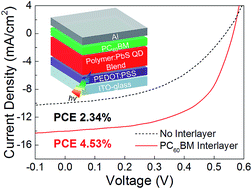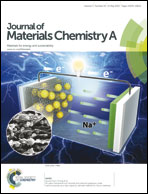A multifunctional fullerene interlayer in colloidal quantum dot-based hybrid solar cells
Abstract
Chemically modifying the surfaces of colloidal quantum dots (QDs) offers an effective approach to improve their photovoltaic performances. Ligand exchange processes, however, tend to cause nanoscale cracks throughout the QD-based films, which increases the leakage current and magnitude of recombination losses. Here, we have developed a multifunctional [6,6]-phenyl C61 butyric acid methyl ester (PC60BM) cathode interlayer for use in polymer–QD hybrid bulk heterojunction (BHJ) solar cells. The PC60BM layer deposited onto the hybrid BHJ film via solution uniformly covered the nanocracks produced by QD surface ligand exchange with thiol and facilitated electron transport to the cathode. The PC60BM layer also improved photon harvesting at short wavelengths and formed an efficient vertical donor–acceptor/acceptor′ (D–A/A′) junction in the interfacial areas between the hybrid blend and PC60BM. The efficient vertical junction increased the probability of ultrafast exciton dissociation, provided pathways for effective transport and extraction of photo-generated electrons, and blocked holes to reduce recombination losses. These combined advantages significantly enhanced the overall efficiency of the hybrid solar cells over the current state-of-the-art efficiency.


 Please wait while we load your content...
Please wait while we load your content...